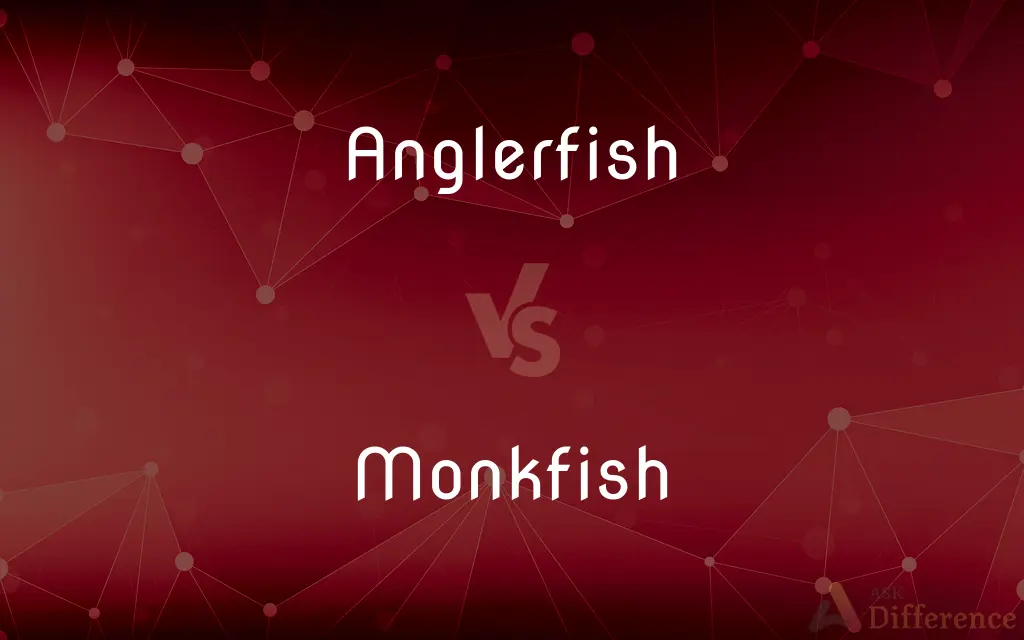Anglerfish vs. Monkfish — What's the Difference?
By Tayyaba Rehman — Updated on November 7, 2023
Anglerfish are deep-sea predators with bioluminescent lures, while Monkfish refers to a specific species, Lophius, often used in cooking.

Difference Between Anglerfish and Monkfish
Table of Contents
ADVERTISEMENT
Key Differences
Anglerfish encompasses a variety of deep-sea fish known for their characteristic luminescent lure, used to attract prey in the dark ocean depths. Monkfish, specifically, refers to members of the genus Lophius, also known as "sea-devils," which are bottom-dwelling fish found in the North Atlantic and Mediterranean. Both anglerfish and monkfish possess a distinctive appearance, marked by their large mouths and flat, wide bodies.
Anglerfish are renowned for their extreme sexual dimorphism, where males are significantly smaller than females and sometimes parasitically attached to females for reproduction. In contrast, monkfish do not exhibit this trait. Both the broader category of anglerfish and the more narrowly defined monkfish are subjects of fascination due to their unusual reproductive strategies.
The term anglerfish generally refers to any fish from the order Lophiiformes, which includes a vast range of species with various adaptations for deep-sea life. Monkfish, within this order, are commonly sought after for their meaty tails and are considered a delicacy in culinary circles. While both anglerfish and monkfish live in deep waters and have similar hunting strategies, monkfish are more relevant to the fishing industry.
In the culinary world, the name monkfish is applied to the species from the genus Lophius, valued for its firm, lobster-like flesh. Anglerfish, while inclusive of monkfish, is rarely used in a culinary context and more often refers to the peculiar fish of the deep sea with their notable predation technique. Anglerfish and monkfish share a commonality in habitat and hunting methods but diverge significantly in their representation in human culture.
While all monkfish are anglerfish, not all anglerfish are considered monkfish. The broader category of anglerfish includes many species with varied appearances and behaviors, whereas monkfish pertains to a specific type within this category, known for their sizable head and mouth. Both anglerfish and monkfish are fascinating creatures of the deep, each with their unique place in the marine ecosystem and human imagination.
ADVERTISEMENT
Comparison Chart
Definition
A diverse group of predatory deep-sea fish with bioluminescent lures.
A specific genus of anglerfish known for its use in cooking.
Habitat
Deep-sea environments worldwide.
North Atlantic and Mediterranean seabeds.
Reproduction
Often extreme sexual dimorphism and parasitic males.
No such extreme dimorphism or parasitism.
Culinary Use
Rarely eaten, not specific to cuisine.
Tail meat is prized in gastronomy.
Common Names
Often referred to based on species and adaptations.
Commonly known as "sea-devils" or "goosefish."
Compare with Definitions
Anglerfish
Deep-sea fish with a luminescent lure.
The anglerfish uses its glowing lure to attract prey in the ocean’s dark depths.
Monkfish
A fish with a wide, flat body and large mouth.
The wide mouth of the monkfish allows it to consume large fish.
Anglerfish
Marine creatures with extreme sexual dimorphism.
The male anglerfish is much smaller than the female, often attaching to her for life.
Monkfish
Culinary term for the tail meat of Lophius species.
Chef prepared a monkfish dish that tasted similar to lobster.
Anglerfish
A term for various predatory fish in the order Lophiiformes.
Scientists discovered a new species of anglerfish in the deep sea.
Monkfish
Commercially fished species from the Lophiiformes order.
The fishing boat’s catch was full of monkfish bound for the market.
Anglerfish
Fish known for their unique hunting strategy.
Anglerfish remain still, using their lure as bait for unsuspecting fish.
Monkfish
A bottom-dwelling anglerfish species.
The monkfish camouflages with the seabed to ambush its prey.
Anglerfish
Fish with an oversized head and mouth.
The anglerfish can swallow prey nearly as large as itself.
Monkfish
Known as "sea-devil" for its grotesque appearance.
The monkfish's appearance belies the delicacy of its flesh.
Anglerfish
The anglerfish are fish of the teleost order Lophiiformes (). They are bony fish named for their characteristic mode of predation, in which a modified luminescent fin ray (the esca or illicium) acts as a lure for other fish.
Monkfish
See goosefish.
Anglerfish
Any of various marine fishes of the order Lophiiformes, having a long dorsal fin ray that is suspended over the mouth and serves as a lure to attract prey.
Monkfish
Any large bottom-dwelling anglerfish of the genus Lophius, such as Lophius piscatorius, of the Atlantic, having a large head and mouth.
Anglerfish
Any fish of the bony fish order Lophiiformes, which have an outgrowth they wiggle to lure and catch their prey.
Monkfish
Angel sharks of the genus Squatina.
Anglerfish
Fishes having large mouths with a wormlike filament attached for luring prey
Monkfish
The angel fish (Squatina).
Monkfish
Flesh of a large-headed anglerfish of the Atlantic waters of North America
Monkfish
Fishes having large mouths with a wormlike filament attached for luring prey
Monkfish
Sharks with broad flat bodies and winglike pectoral fins but that swim the way sharks do
Common Curiosities
How do anglerfish hunt?
Anglerfish use a bioluminescent lure to attract and ambush prey.
Can you eat anglerfish?
While some anglerfish can be eaten, monkfish is the species most commonly consumed.
Are anglerfish dangerous to humans?
No, anglerfish are not dangerous to humans as they live in depths not frequented by people.
What is the biggest threat to monkfish populations?
Overfishing is the biggest threat to monkfish populations.
What distinguishes anglerfish from monkfish?
Anglerfish refers to a broad category of deep-sea fish with luminescent lures, while monkfish specifically refers to the genus Lophius, which is also a type of anglerfish used in cooking.
What does monkfish taste like?
Monkfish is known for its firm, sweet, and mild taste, similar to lobster.
What is the habitat of an anglerfish?
Anglerfish typically inhabit deep-sea environments.
How is monkfish meat harvested?
Monkfish meat is harvested through commercial fishing techniques.
Is monkfish meat expensive?
Monkfish meat can be expensive due to its high demand and comparison to lobster.
Do anglerfish have predators?
Anglerfish have few predators due to their deep-sea habitat and camouflage abilities.
Why don't we commonly see anglerfish?
We rarely see anglerfish because they live in deep, dark parts of the ocean.
How does monkfish contribute to the ecosystem?
Monkfish are predators that help maintain the balance of marine life on the seabed.
What adaptations do anglerfish have?
Anglerfish have adaptations like bioluminescent lures and camouflaged bodies for deep-sea survival.
What part of monkfish is edible?
The tail meat is the most commonly eaten part of the monkfish.
Can anglerfish be kept in aquariums?
Due to their habitat requirements, anglerfish are not typically kept in personal aquariums.
Share Your Discovery

Previous Comparison
Intuitive vs. Presentative
Next Comparison
Engulf vs. IngulfAuthor Spotlight
Written by
Tayyaba RehmanTayyaba Rehman is a distinguished writer, currently serving as a primary contributor to askdifference.com. As a researcher in semantics and etymology, Tayyaba's passion for the complexity of languages and their distinctions has found a perfect home on the platform. Tayyaba delves into the intricacies of language, distinguishing between commonly confused words and phrases, thereby providing clarity for readers worldwide.















































